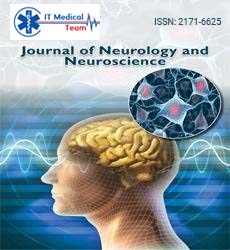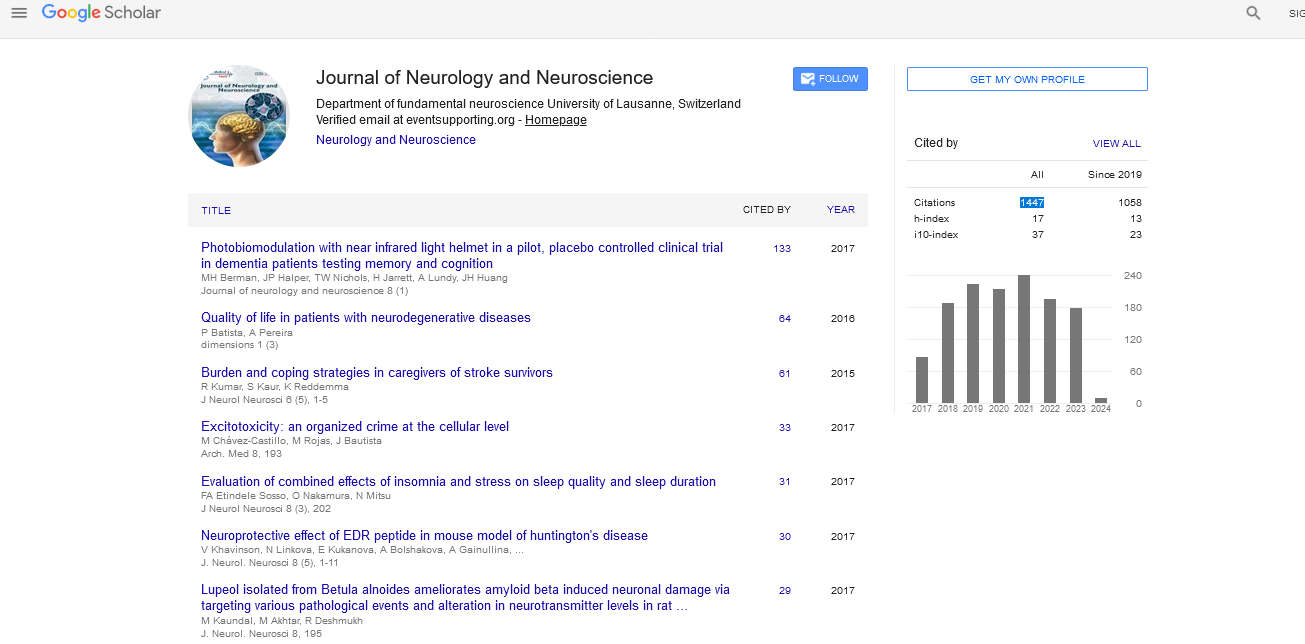Opinion - (2024) Volume 15, Issue 6
Pseudotumor cerebri syndrome with a concurrent retroperitoneal cyst: An unusual case report
Chenge Hinel*
Department of Neurology, Chonnam National University Medical School, Gwangju, Republic of Korea
*Correspondence:
Chenge Hinel, Department of Neurology, Chonnam National University Medical School, Gwangju,
Republic of Korea,
Email:
Received: 27-Nov-2024, Manuscript No. ipjnn-25-15495;
Editor assigned: 29-Nov-2024, Pre QC No. P- 15495;
Reviewed: 13-Dec-2024, QC No. Q-15495;
Revised: 18-Dec-2024, Manuscript No. R-15495;
Published:
25-Dec-2024
Abstract
Pseudotumor Cerebri Syndrome (PTCS), also known as idiopathic Intracranial Hypertension (IIH), is a condition characterized by Increased Intracranial Pressure (ICP) in the absence of any identifiable cause such as a brain tumor, hydrocephalus, or venous thrombosis. It is often associated with symptoms such as headache, papilledema (swelling of the optic disc), visual disturbances, and sometimes, in severe cases, permanent vision loss. PTCS primarily affects women of childbearing age, though it can occur in men and children as well. The cause of PTCS remains unclear, but it is thought to involve factors such as obesity, hormonal changes, and venous outflow abnormalities. One of the most challenging aspects of diagnosing and treating PTCS is distinguishing it from other conditions that present with similar symptoms. Occasionally, PTCS can be complicated by other comorbidities, making diagnosis and management more complex. One such example is the rare case where PTCS is seen in conjunction with a retroperitoneal cyst. This case report explores the unique presentation of a patient diagnosed with both pseudotumor cerebri syndrome and a massive retroperitoneal cyst, highlighting the diagnostic challenges, clinical course, and therapeutic considerations involved in managing this unusual clinical scenario
INTRODUCTION
Pseudotumor Cerebri Syndrome (PTCS), also known as idiopathic Intracranial Hypertension (IIH), is a condition characterized by Increased Intracranial Pressure (ICP) in the absence of any identifiable cause such as a brain tumor, hydrocephalus, or venous thrombosis. It is often associated with symptoms such as headache, papilledema (swelling of the optic disc), visual disturbances, and sometimes, in severe cases, permanent vision loss. PTCS primarily affects women of childbearing age, though it can occur in men and children as well. The cause of PTCS remains unclear, but it is thought to involve factors such as obesity, hormonal changes, and venous outflow abnormalities. One of the most challenging aspects of diagnosing and treating PTCS is distinguishing it from other conditions that present with similar symptoms. Occasionally, PTCS can be complicated by other comorbidities, making diagnosis and management more complex. One such example is the rare case where PTCS is seen in conjunction with a retroperitoneal cyst. This case report explores the unique presentation of a patient diagnosed with both pseudotumor cerebri syndrome and a massive retroperitoneal cyst, highlighting the diagnostic challenges, clinical course, and therapeutic considerations involved in managing this unusual clinical scenario [1].
DESCRIPTION
A 32-year-old female presented to the emergency department with a history of persistent headaches, visual disturbances, and intermittent nausea for the past three months. She described the headaches as being dull, constant, and worsened by movement or changes in position. She also noted occasional blurriness in her vision, especially in the peripheral fields, along with a feeling of pressure behind her eyes. The patient had no history of trauma, and there was no history of fever, vomiting, or seizures. Her medical history included obesity, which had developed over the past few years, and she was on oral contraceptives for menstrual irregularities. Upon initial examination, the patient appeared overweight, with a Body Mass Index (BMI) of 32 kg/m². She had no fever or focal neurological deficits. However, a thorough eye examination revealed bilateral papilledema, which was consistent with increased intracranial pressure. Visual field testing showed mild peripheral visual field loss. A neurological examination revealed normal motor, sensory, and coordination findings, suggesting that her symptoms were primarily related to elevated ICP [2]. Given the clinical presentation of headache, visual disturbances, and papilledema, the differential diagnosis included conditions like brain tumors, venous thrombosis, and hydrocephalus. However, imaging studies, including an MRI of the brain with contrast and a CT venogram, did not show any masses, venous sinus thrombosis, or hydrocephalus. The MRI findings revealed no structural brain abnormalities, but 2 − 15 (06) 2022: 001-002 © J Neurol Neurosci 1. Friedman DI, Liu GT, Digre KB. Revised diagnostic criteria for the pseudotumor cerebri syndrome in adults and children. Neurology. 2013; 81(13):1159-1165. 2. Rison RA, Kidd MR, Koch CA. The CARE (Case Report) guidelines and the standardization of case reports. J Med Case Rep. 2013; 7:1-3. 3. Markey KA, Mollan SP, Jensen RH, et al. Understanding idiopathic intracranial hypertension: Mechanisms, management, and future directions. Lancet Neurol. 2016; 15(1):78-91. 4. Kim TW, Choung HK, Khwarg SI, et al. Obesity may not be a risk factor for idiopathic intracranial hypertension in Asians. European journal of neurology. 2008 Aug; 15(8):876-879. 5. Chen J, Wall M. Epidemiology and risk factors for idiopathic intracranial hypertension. International ophthalmology clinics. 2014 Jan 1; 54(1):1-1. there was evidence of moderate ventricular dilation, which is commonly seen in PTCS. Furthermore, an MR venography ruled out venous obstruction. To further assess the cause of increased intracranial pressure, a lumbar puncture was performed, which revealed an opening pressure of 35 cm H2O, confirming the diagnosis of PTCS. The Cerebrospinal Fluid (CSF) analysis was otherwise normal, with no signs of infection or other pathology [3]. While evaluating the patient’s symptoms, a routine abdominal ultrasound was performed to assess for potential abdominal causes of nausea and discomfort. The ultrasound revealed a large, well-defined mass in the retroperitoneal space, measuring approximately 10 cm in diameter. A subsequent contrast-enhanced CT scan of the abdomen confirmed the presence of a large, non-communicating retroperitoneal cyst located adjacent to the left kidney. The cyst was described as simple, unilocular, and contained clear fluid with no signs of malignancy or infection. The cyst’s size and location were noted to be unusual, but it was not initially considered to be directly related to the patient’s neurological symptoms. The presence of the retroperitoneal cyst raised questions regarding its potential impact on the patient’s condition. Although the cyst did not appear to be directly related to the brain or the intracranial pressure, it was important to rule out any vascular or anatomical abnormalities that could contribute to the patient’s symptoms. The possibility of the cyst compressing surrounding structures and affecting venous drainage or cerebrospinal fluid dynamics was considered. The patient was diagnosed with Pseudotumor Cerebri Syndrome and was started on standard treatment for PTCS. Initial management included medical therapy with acetazolamide, a carbonic anhydrase inhibitor that reduces CSF production and helps to lower intracranial pressure. The patient was also advised to lose weight, as obesity is a significant risk factor for PTCS. In addition, she was prescribed a diuretic (furosemide) to help manage her symptoms of fluid retention and increase the effectiveness of acetazolamide. Over the next few weeks, the patient’s headache severity decreased, and her visual symptoms improved. However, her papilledema persisted, indicating that intracranial pressure had not yet normalized. Repeat neuroimaging was performed to monitor any changes in brain structure, but no new abnormalities were identified. The management team continued to monitor her symptoms and response to treatment [4]. The presence of a retroperitoneal cyst in a patient with PTCS presented a diagnostic challenge. While it was tempting to attribute the patient’s symptoms solely to the intracranial hypertension, the large cyst in the retroperitoneum required careful consideration. The possibility of a venous sinus thrombosis was ruled out with imaging, including MR venography and CT venography, which showed no evidence of vascular occlusion. Although the cyst was large, it did not appear to cause significant compression of adjacent organs or blood vessels. The mass did not appear to affect the renal veins or the inferior vena cava, making it an unlikely cause of increased intracranial pressure. While the cyst was retroperitoneal, its proximity to the renal system raised questions about any hormonal disturbances, particularly in relation to the hypothalamic-pituitary axis, which could potentially contribute to symptoms of elevated intracranial pressure. However, no hormonal irregularities were found during testing, and the cyst was ultimately considered non-endocrine in nature [5].
CONCLUSION
This case report highlights a rare and unusual presentation of pseudotumor cerebri syndrome complicated by the discovery of a large retroperitoneal cyst. Although the cyst did not appear to directly impact intracranial pressure, its presence required careful consideration in the differential diagnosis. The patient’s management involved a combination of medical therapy for PTCS, including acetazolamide and weight loss strategies, alongside ongoing monitoring of the retroperitoneal cyst. The key takeaway from this case is that PTCS can occur in conjunction with other comorbidities, and a multidisciplinary approach is essential for managing such complex cases. The discovery of a retroperitoneal cyst in a patient with PTCS underscores the importance of considering the entire clinical picture and conducting thorough diagnostic workups. While this cyst did not directly affect the patient’s neurological symptoms, ongoing monitoring and follow-up imaging were necessary to ensure early detection of any potential complications. Ultimately, the patient’s condition stabilized, and her symptoms were managed effectively, but continued vigilance was required due to the rarity and complexity of this case.
REFERENCES
<ol>
<li><a name="1" id="1"></a><strong>Friedman DI, Liu GT, Digre KB</strong>. <a href="https://www.neurology.org/doi/abs/10.1212/wnl.0b013e3182a55f17" target="_blank">Revised diagnostic criteria for the pseudotumor cerebri syndrome in adults and children</a>. <em>Neurology</em>. 2013; 81(13):1159-1165.</li>
<p align="right"><a href="https://scholar.google.com/scholar_lookup?title=Revised+diagnostic+criteria+for+the+pseudotumor+cerebri+syndrome+in+adults+and+children&author=Friedman,+D.I.&author=Liu,+G.T.&author=Digre,+K.B.&publication_year=2013&journal=Neurology&volume=81&pages=1159%E2%80%931165&doi=10.1212/WNL.0b013e3182a55f17&pmid=23966248" target="_blank"><u>Google Scholar</u></a>, <a href="https://doi.org/10.1212/WNL.0b013e3182a55f17" target="_blank"><u>Crossref</u></a>, <a href="https://www.ncbi.nlm.nih.gov/pubmed/23966248"" target="_blank"><u>Indexed at</u></a></p>
<li><a name="2" id="2"></a><strong>Rison RA, Kidd MR, Koch CA.</strong> <a href="https://link.springer.com/article/10.1186/1752-1947-7-261" target="_blank">The CARE (Case Report) guidelines and the standardization of case reports</a>. <em>J Med Case Rep</em>. 2013; 7:1-3.</li>
<p align="right"><a href="https://scholar.google.com/scholar_lookup?title=The+CARE+(CAse+REport)+guidelines+and+the+standardization+of+case+reports&author=Rison,+R.A.&author=Kidd,+M.R.&author=Koch,+C.A.&publication_year=2013&journal=J.+Med.+Case+Rep.&volume=7&pages=261&doi=10.1186/1752-1947-7-261&pmid=24283496" target="_blank"><u>Google Scholar</u></a>, <a href="https://doi.org/10.1186/1752-1947-7-261" target="_blank"><u>Crossref</u></a>, <a href="https://www.ncbi.nlm.nih.gov/pubmed/24283496"" target="_blank"><u>Indexed at</u></a></p>
</ol>





